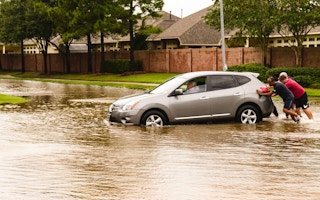A new study carried out by engineers from the University of New South Wales (UNSW), Sydney and published this month (August) in Nature Scientific Reports, analysed real-world effects of river flows and rainfall data from over 160 countries.
The researchers noted that there’s a radical shift in streamflow patterns with more intense rainfall in cities, overwhelming infrastructure and causing flooding. But there’s also a puzzling observed phenomenon of drier soils and reduced water flow in rural areas.
“
It’s a double whammy. More people are moving to cities where floods are becoming more frequent and intense. At the same time, rural areas may be becoming drier with reduced river flows impacting on agricultural productivity and food security.
Conrad Wasko, University of New South Wales
The answer turned out to be the other facet of rising temperatures: more evaporation from moist soils is causing them to become drier before any new rain occurs.
Conrad Wasko, lead author of the study, says: “It’s a double whammy. More people are moving to cities where floods are becoming more frequent and intense. At the same time, rural areas may be becoming drier with reduced river flows impacting on agricultural productivity and food security.”
In 2013, global flood damage cost more than US$50 billion and this is expected to more than double in the next 20 years. During the same period, the global population is forecast to rise to 9 billion from the current 7.3 billion.
“We need to adapt to this emerging reality. For example, in the drier middle-eastern countries, water security is provided through extensive re-engineering in the form of desalination plants. Israel has a very high-efficiency drip irrigation in place that wastes minimal water,” says Ashish Sharma, professor of hydrology at UNSW and study co-author.
Sharma also points to China’s water-transfer project which involves taking water from the south (including the upper Mekong) and transferring it to the north where it is needed more.
To combat the problems raised by the study, Sharma suggests three engineering solutions — water-sensitive urban design for urban centres, reducing evaporation in farms through more efficient irrigation and water transfer from areas with abundant resources to drier areas.
Oxfam Australia’s climate change policy advisor Simon Bradshaw says the analysis highlights the grave impacts of climate change on food, livelihoods and human security.
“The findings strongly reaffirm the need to minimise future impacts through far more urgent international action to curb carbon pollution while increasing the resources available to urban and rural populations alike to adapt to the changes they are facing.”
Bradshaw says there is insufficient funding flowing from rich, developed countries to vulnerable communities around the world for building resilience against the escalating impacts of climate change.
“Boosting access to finance for climate change adaptation will be a key priority for this year’s international climate talks, hosted by Fiji in November.”
This piece was produced by SciDev.Net’s Asia & Pacific desk.










